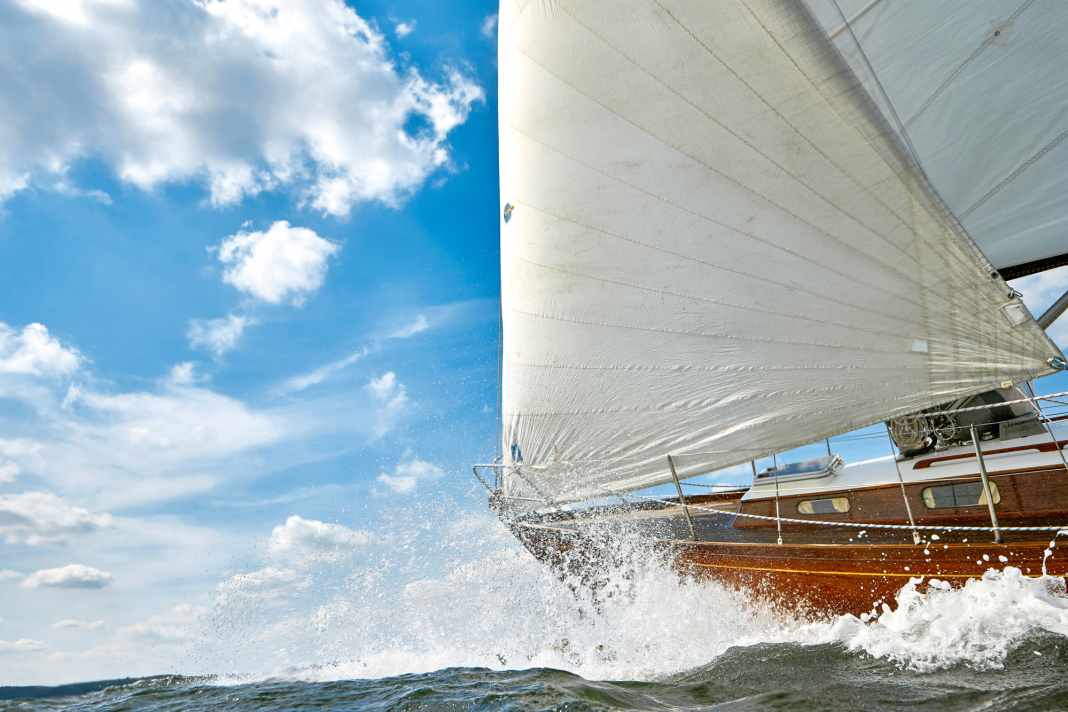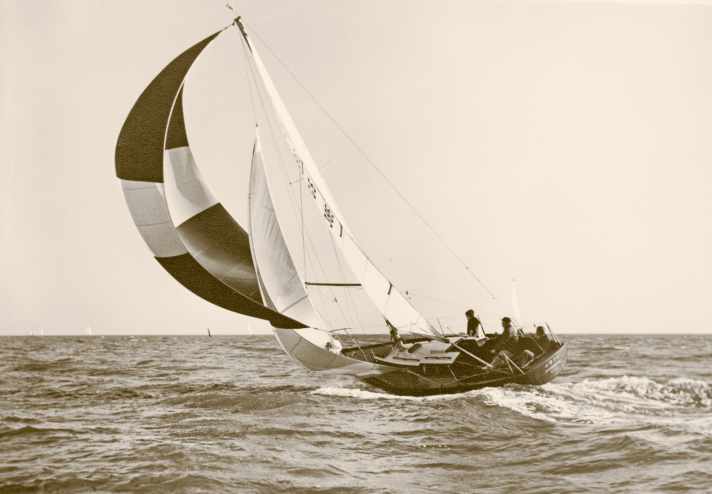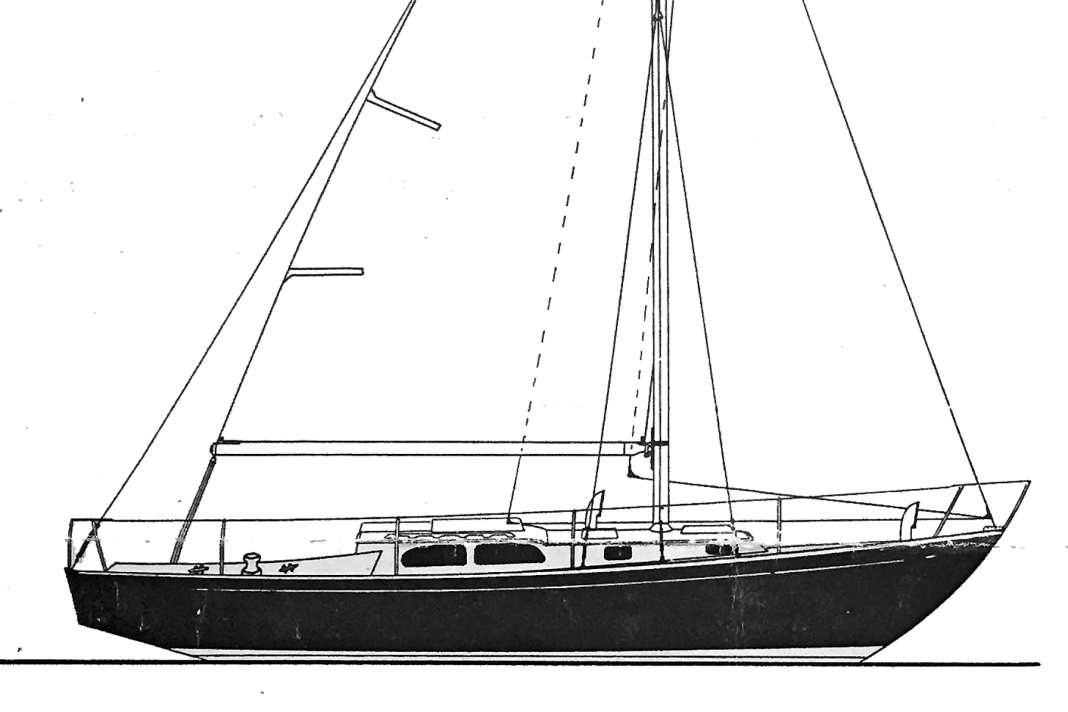





- 5-KR yacht type "Götz
- The model for "Kleine Brise" is Bill Tripp's favourite yacht - a GRP boat
- Still a strong regatta participant today
- Nothing is missing below deck, the interior has furniture quality
- You can't tell that "Kleine Brise" is 55 years old
- Technical data of the 5-KR yacht "Kleine Brise"
"That's my most favoured yacht!" - that's my most favourite yacht! When designer William H. Tripp Jr., known as "Bill", says this, he is praising an early GRP production boat that has been built in Holland for a New York general importer since the early 1960s and has been marketed overseas with great success. It epitomises an entire era of yachts that still look the same in terms of design, but are already made from the then newly emerging boatbuilding material.
Glass fibres bonded with synthetic resin - not every sailor is comfortable with the idea of entrusting their life to this still completely untested material. In those early days, it was hard to imagine that "glass resin" would rapidly revolutionise traditional boatbuilding and eventually almost replace it. And so there are still new boats on the market made of plywood, moulded or traditionally planked wood - albeit with a decreasing tendency.
The "Kleine Brise", a 5-KR yacht of the "Götz" type, a shipyard class that was first built by Joh. de Dood & Sohn from Bremen in 1966, bears particularly impressive witness to this period of unprecedented upheaval. At the time, the "Kleine Brise" was the last new yacht to be built from solid wood at the Hamburg Boat Show. And her role model is - of all things - a plastic boat.
5-KR yacht type "Götz

The collaboration between the Bremen yacht shipyard Joh. de Dood & Sohn and the American designer Bill Tripp led to the first of a whole series of sister ships being built in 1966. The nine-metre "Götz", named after the shipyard manager Henry Rosskamp, cut a fine figure on the regatta course and, as a true cruiser/racer, was equipped with a furniture-like interior on the shipyard side. The model was a construction that had been manufactured in GRP since the early 1960s, which was modified for timber construction at de Dood - exactly the opposite of what was customary at the time.
The model for "Kleine Brise" is Bill Tripp's favourite yacht - a GRP boat
"A ship drawn by Tripp with an overall length of nine metres was currently being built in Holland from plastic," recalls De-Dood operations manager Henry Rosskamp in his memoirs of the design quoted at the beginning, "the so-called Tripp-Lentsch 30. I personally liked the ship very much, but it was out of the question as a plastic ship either in terms of material or cost. Bill allowed me to redraw the ship in conventional timber construction and build it for myself."
The American was 45 years old at the time and already a star designer. Tripp subscribed to cruisers/racers, his signature style was restrained superstructures, a pronounced deck step, which led to a high bow with an already high freeboard. As much attention as Tripp devotes to fast underwater boats, the aesthetic appearance of his designs, which are characterised by balanced proportions and a classic look, is just as important to him. With the Hinckley Bermuda 40, he had already presented his best-known design years earlier. The fact that he allowed Rosskamp to modify his design at the time is testament to his greatness.
And so the unbelievable happens. While moulds of wooden boats were being accepted for GRP construction everywhere, the opposite approach was taken on the Weser - back to the future. Rosskamp's yacht is launched in 1967 as the "Götz IV" and gives its name to the future shipyard class; although, according to the list of construction numbers, the first yacht of the new type was actually delivered to a Hamburg customer a year earlier. The "Kleine Brise" was completed in spring 1969 with the construction number 518. She makes her first journey overland - to the halls of the Hamburg Boat Show.
"Little breeze" is an orchid in the daisy field
Its ninth edition is the occasion for a page-long report in YACHT 5/1969 entitled "Glanz ist Trumpf". The "Kleine Brise", still unchristened as the "Götz" type, is also mentioned. What's more, the reporter literally gushes: "At this GRP show, the 'Götz' looked like an orchid in a field of daisies. Her workmanship, African mahogany on glued oak frames and teak decks, represents the optimum in yacht building quality. The 'Götz' already proved her excellent sailing qualities in the regattas of the Kieler Woche 1968."
In fact, Rosskamp had already shown the speed potential of his small sea cruiser in the first season. At the Weser-Jade Week in 1967, he sailed to four first prizes and five special prizes in four races.
It was the era of the KR formula that gave the domestic yacht fleet its conventional character at a time when the split lateral plan and lightweight construction had long been invented. The 1949 formula goes back to a suggestion by Henry Rasmussen and ensured a supply of long keels with S frames right into the seventies. The inhabitants of the German coasts of the North Sea and Baltic Sea have long regarded them as the ideal cruising yacht, and so it is taken for granted that they are also used on the regatta course.
Still a strong regatta participant today
The "Kleine Brise" will also be at the start of the 30th German Classics 2018. The atmosphere on board is one of ambitious anticipation. Two long-serving co-sailors and the skipper form a well-rehearsed crew, the handholds are in place and the friends cheer each other on with pithy remarks.
The "Kleine Brise" makes it easy for her crew. The dimensions of nine by 2.74 metres are manageable, the sail area of 30 square metres is easy to handle, and the three and a half tonne displacement is extremely low for a traditionally built wooden boat of this size. The weight is well distributed throughout the boat, the engine is under the saloon table and the overhangs are empty. In the large cockpit, everyone has their own workstation, with the helmsman sitting close behind the superstructure bulkhead at the tiller and the main and foresail skipper behind.
The wind is blowing strongly on this sunny day, and the short, steep wave on Kiel's outer fjord is challenging. But the "Kleine Brise" copes well with this and crosses the start line under main and genoa II and fights her way to windward. Many of the competitors stay astern. On the downwind course, the spinnaker is set with the curt comment "Fun is a must". The wind has picked up again, it's close to the limit. Twice the "Kleine Brise" almost shoots into the sun - but only almost. At no point does the helmsman lose control of his ship. In the end, "Kleine Brise" finished third in its group according to the calculated time.
Nothing is missing below deck, the interior has furniture quality
The owner at the time, Arnulf Dahm, bought the "Kleine Brise" primarily for extended trips on the Baltic Sea (editor's note: this article first appeared in YACHT 06/2019, "Kleine Brise" has since been sold). He then sits at the tiller, which ends far forward in the cockpit, protected under the sprayhood. Dahm goes on summer holidays with his wife, friends or even single-handed, preferably to places where other classic boat enthusiasts meet. In 2012, he attended the anniversary regatta "100 Years Summer Olympics Stockholm" and was present at all the Classic Weeks organised by the Circle of Friends.
Dahm remembers well that the suitability for cruising sailing in particular immediately struck him when he stepped aboard his boat for the first time. "What really fascinated me was the size and utilisation of the available interior space," he says. Because although his gem is a small yacht by today's standards, it lacks nothing below deck. In the saloon, there is a navigation station, galley, sofa berths and folding table as well as various lockers and drawers; an enclosed toilet room and a large cupboard are fitted in front. The interior is still in top condition with high-quality furniture. The atmosphere below deck is dignified, with numerous details such as the elegant saloon floor or the elaborately crafted stanchions testifying to the shipyard's claim to set standards in boatbuilding.
It was in December 2010 that Dahm succumbed to this charm. At the time, he had just sold his old boat. But he knew the "Kleine Brise", and she had long haunted his dreams as the ideal successor. When the previous owner actually expressed his intention to sell, he took up the scent, with the familiar result.
Modesty is the trump card at the Bremen shipyard
"My previous owner loved his boat and had a lot done to it in the ten years we spent together," says Dahm, "I was totally taken with its condition." Then there are the dimensions and the extremely low weight. "For me, who does a lot of travelling alone, it was so tempting that I said, this is exactly my boat."
And there is something else that will delight wooden boat fans: the legendary quality workmanship of the Bremen shipyard. "Construction: solid wood on glued frames", the brochure states succinctly. Alongside praise for the design and regatta suitability, there is not a word about the selection of high-quality wood or the elaborate glued construction method that ensures that the "Kleine Brise" still has a dust-dry bilge today. Not a word about the bronze floor cradles or the stainless steel diagonal stringers in the mast area, where competitor boats have often had problems over the years.
Even missing words say something. At de Dood, the term yacht building was narrowly defined. In the early seventies, owner Cornelius de Dood was quoted in YACHT as saying that 90 per cent of the shipyards that had tried their hand at building wooden ships did not have the operational prerequisites for this. These included air-conditioned halls and drying chambers for the wood.
Cornelius de Dood rebuilt the shipyard founded by his father in 1921 after the war. When the keel of the "Kleine Brise" was laid here, the business had reached its zenith. More than half of the newbuildings were built for American account, with big names such as Olin Stephens coming to approve them.
You can't tell that "Kleine Brise" is 55 years old
Regatta yachts with names such as "Esprit", "Wappen von Bremen", "Hamburg", "Diana", "Inshallah" or "Carina" are built here; however, the industrialisation of yacht building has overtaken the conventional business like an avalanche. New materials were only half-heartedly accepted and a labour cost share of 50 to 70 percent was standard, but no longer in keeping with the times. The last new build was launched in the mid-seventies.
In the years before Dahm's ownership, the "Kleine Brise" was a regular guest at the shipyard of a former master boat builder from de Dood, who had many of these jewels in his care. "The outer skin was planed through and rebuilt, the superstructure was given a new thick veneer and the teak deck was completely replaced," says Dahm. His aim was to maintain this good condition. "I need about eight weekends in the winter season for this," says Dahm.
All wooden parts are then finished. "The surface is now so fantastic that you only have to sand it very lightly with 320-grit paper, then I can paint it with a roller and finishing brush," explains Dahm, adding that the effort involved is not much greater than an intensive gelcoat polish.
Unexplained history of the small yacht
In most cases, however, there would also be a larger project. Sometimes it was the ageing electrics, then the engine needed a cure and new foundations. The rigging was also overhauled as part of one of these winter projects. Dahm had the mast and boom powder-coated.
His current project is researching the history of his yacht, the trail of which is lost in the wake of its previous owner. According to the construction number book, the "Kleine Brise" was built exactly 50 years ago by the shipyard on its own account and completed in time for the Hamburg Boat Show. It is unclear who bought her there and which hands she passed through.
But what does it matter - after all, the "Kleine Brise" sails in the here and now. She will be 55 years old this summer, but you wouldn't know it by looking at her. Neither on the water, where she is as agile as ever, writing her nautical miles in the wake, nor in the harbour - where she actually looks a little like an orchid in a field of daisies.
Technical data of the 5-KR yacht "Kleine Brise"



- Design engineer: Bill Tripp
- Building yard: de Dood
- Total length: 9,00 m
- LWL: 8,30 m
- Width: 2,74 m
- Depth: 1,35 m
- Displacement: 3,6 t
- sail area: 32 m2
The article first appeared in YACHT 06/2019 and has been updated for the online version.

